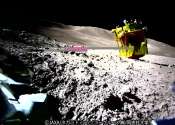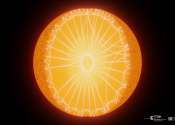Japan moon probe survives second lunar night
Japan's moon lander woke up after unexpectedly surviving a second frigid, two-week lunar night and transmitted new images back to Earth, the country's space agency said Thursday.

Japan's moon lander woke up after unexpectedly surviving a second frigid, two-week lunar night and transmitted new images back to Earth, the country's space agency said Thursday.
Space Exploration
Mar 28, 2024
0
311

At a distance of 11.9 light years, Epsilon Indi (ε Indi) is an orange dwarf star (also known as a K dwarf) with 71% of the sun's diameter. An international team, led by Instituto de Astrofísica e Ciências do Espaço (IA) ...
Astronomy
Mar 26, 2024
0
39

Billions of years ago, Mars was home to abundant water, and its Gale crater contained a lake. Gradually, the climate changed, drying the red planet and creating the dusty desert world we know today.
Planetary Sciences
Mar 22, 2024
1
1342

Pharmaceutical waste and contaminants present a growing global concern, particularly in the context of drinking water and food safety. Addressing this critical issue, a new study by researchers at Bar-Ilan University's Department ...
Bio & Medicine
Mar 21, 2024
0
50

From abstract-looking cloud formations to roars of snow machines on ski slopes, the transformation of liquid water into solid ice touches many facets of life. Water's freezing point is generally accepted to be 32 degrees ...
Analytical Chemistry
Mar 20, 2024
0
112

Images projected onto objects in the real world create impressive displays that educate and entertain. However, current projection mapping systems all have one common limitation: they only work well in the dark. In a study ...
Optics & Photonics
Mar 18, 2024
0
17

Accurate climate data is immensely important for climate change predictions and modeling. Using a unique climate data set of 170 stations, mainly from the mountains of Tanzania including Kilimanjaro, Dr. Andreas Hemp, researcher ...
Earth Sciences
Mar 15, 2024
0
12

One of the primary goals in the field of tissue engineering and regenerative medicine is the development of artificial scaffolds that can serve as substitutes for damaged tissue. These materials must ideally resemble natural ...
Polymers
Mar 13, 2024
0
36

Glasses are ubiquitous materials found in building materials, beverage containers, soft electronics, and mobile phone screens. The creation of naturally dense and rigid glass occurs through a process known as aging. It involves ...
Analytical Chemistry
Mar 13, 2024
0
39

Cicadas are the soundtrack of summer, but their pee is more special than their music. Rather than sprinkling droplets, they emit jets of urine from their small frames. For years, Georgia Tech researchers have wanted to understand ...
Soft Matter
Mar 11, 2024
1
415